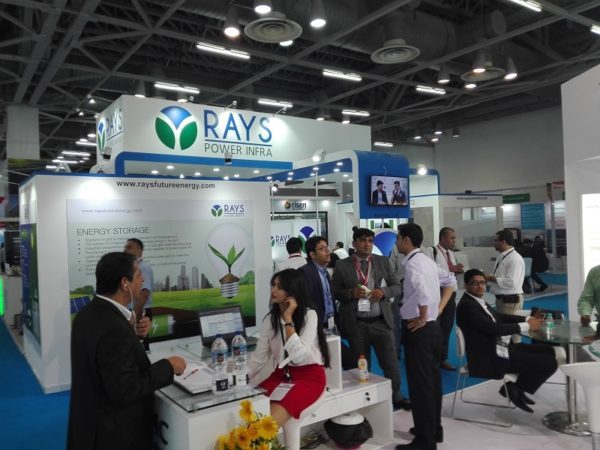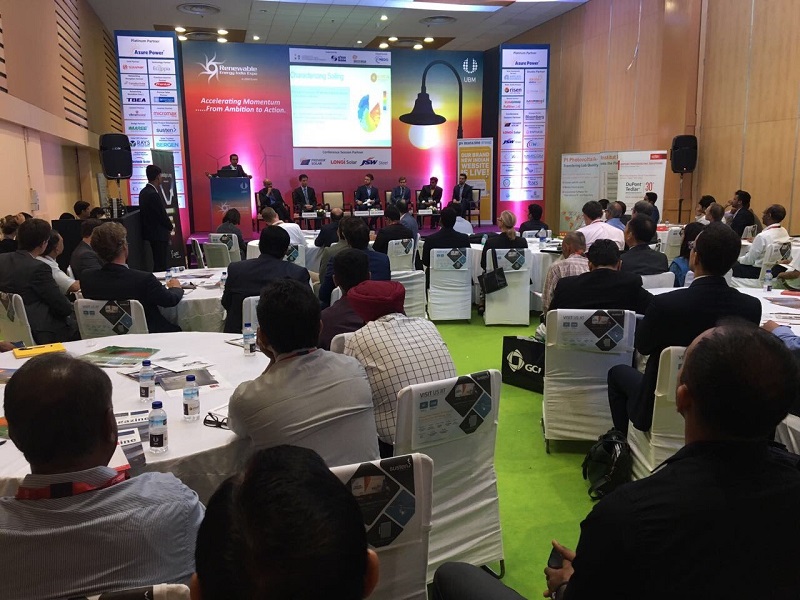The second day of the Renewable Energy India (REI) exhibition in Delhi proved to be a dizzyingly busy one, with one of the highlights being the seventh pv magazine Quality Roundtable, which saw a packed room of engaged Indian solar stakeholders interact with a panel of experts from across the PV value chain.
The event, organized in collaboration with initiative sponsor DuPont, focused on what steps Indian investors, installers and stakeholders can take to ensure the best quality when procuring, building and maintaining solar farms in India.
DuPont’s Oakland Fu began proceedings by presenting the company’s latest field analysis of module degradation and delamination of solar plants in China, prompting the audience to ask what steps they should take to minimize issues concerning backsheet faults, as well as how to act if faults are identified.
This theme was explored further in a case study of a 5 MW solar plant in Rajasthan, presented by Subrahmanyam Pulipaka of Soreva. Olivier Haldi of Stäubli then spoke about how connectors and cabling – small components often given barely a second thought by installers – can impact a plant’s performance and yield in a big way. The audience were keen to understand what steps they should be taking to identify poorly performing cables and connectors, and what specific tests are available.
Haldi also explored how poor installation practices such as cross-connection can also restrict a plant’s performance, explaining that Stäubli is creating training and tutorial programs to bring to India to help minimize these issues.
The training of local personnel was a recurring theme throughout the entire REI show, and Sanjeev Kumar of NEXTracker said that the U.S. company has already trained 200 people in India to improve the installation of its tracker systems. Steven Xuereb of PI Berlin followed that up with a checklist of good O&M best practice that investors should be aware of even at the procurement stage.
The second session switched its attention to examining module quality, and Tom Thieme of LayTec began by highlighting how to find the root cause of module and cell defects. “LayTec presented and discussed with Indian PV manufacturer the need for standardized EVA/BS crossed linking measurement, compared to Gel content to improve the module quality,” Thieme said. “Furthermore, we addressed how our new LIDSCOPE tool can investigate the LID effect at the cell level.”
Gregor Reddemann of M10 Industries then exhibited a 3D video of the company’s Kubus stringer machine, explaining how its uninterrupted production capability can produce up to 5,500 cells per hour and thus deliver higher quality and reduced floorspace for manufacturers. The event was wrapped up by George Touloupas of Clean Energy Associates (CEA) who explained the quality assurance steps on module performance that investors should look out for.
Trade case holds few concerns.  Out on the exhibition floor the mood was one of determination to see India’s solar manufacturing landscape stand on its own two feet, and to do so not with outdated or obsolete technology, but with state-of-the-art capabilities that will place India at the top table of solar producing nations. However, given the current low costs seen at auction across the country, there is an understanding that the government would like to first and foremost hit its goal of 100 GW of solar by 2022 – and thus is unlikely to impose antidumping duties on Chinese and Taiwanese solar components.
Out on the exhibition floor the mood was one of determination to see India’s solar manufacturing landscape stand on its own two feet, and to do so not with outdated or obsolete technology, but with state-of-the-art capabilities that will place India at the top table of solar producing nations. However, given the current low costs seen at auction across the country, there is an understanding that the government would like to first and foremost hit its goal of 100 GW of solar by 2022 – and thus is unlikely to impose antidumping duties on Chinese and Taiwanese solar components.
“The tariff of INR 2.65/kWh seen in the latest Gujarat 500 MW auction is, to me, an indication that developers in that state – which is the home state of Prime Minister Narendra Modi – have caught wind that there will be no duties imposed on Chinese cells or modules,”
Vikas Singh, sales manager for Jinchen, told pv magazine.According to Singh, despite this rate representing a slight increase on the INR 2.44/kWh seen in Rajasthan earlier this year, the tariff is still very low, and would only be viable with lower-cost Chinese components. Given the ties that developers in Gujarat are likely to have to central government, he mused, this is a strong indication that the current AD investigation will not result in punitive tariffs against China.
MYSUN, a Delhi-based developer of India’s first solar rooftop calculator, also struck a deal this week that suggested it harbored few concerns about the trade investigation. The company has partnered with China’s GCL to develop a home solar kit that can be sold as a 1 kW or 3 kW all-in-one bundle to homeowners. GCL will supply the solar modules, and MYSUN will install the array, offering a range of finance options too.
REC, meanwhile, told pv magazine that whatever the outcome of the trade case, its approach towards the Indian market is one of quality over quantity. The Norway-headquartered solar module developer is the leading European supplier in India, and Rohit Kumar, head of Indian Subcontinent, said that EPCs in India know that REC modules come at a 20-25% premium above normal ASPs in the country, but that a growing number of developers are willing to pay this as the market gains a greater thirst for higher yields and improved standards.
In a September report on the Indian solar industry, Mercom Capital Group published data that showed that, after falling by approximately 5% in the second quarter of 2017, for the first time in years ASPs for Chinese modules are increasing in India. “Chinese module ASPs had risen by almost 12% as of August 2017 compared to Q2 2017. By comparison, module ASPs dropped by 12 percent from Q2 2016 to Q3 2016,” the report said.
This content is protected by copyright and may not be reused. If you want to cooperate with us and would like to reuse some of our content, please contact: editors@pv-magazine.com.








By submitting this form you agree to pv magazine using your data for the purposes of publishing your comment.
Your personal data will only be disclosed or otherwise transmitted to third parties for the purposes of spam filtering or if this is necessary for technical maintenance of the website. Any other transfer to third parties will not take place unless this is justified on the basis of applicable data protection regulations or if pv magazine is legally obliged to do so.
You may revoke this consent at any time with effect for the future, in which case your personal data will be deleted immediately. Otherwise, your data will be deleted if pv magazine has processed your request or the purpose of data storage is fulfilled.
Further information on data privacy can be found in our Data Protection Policy.